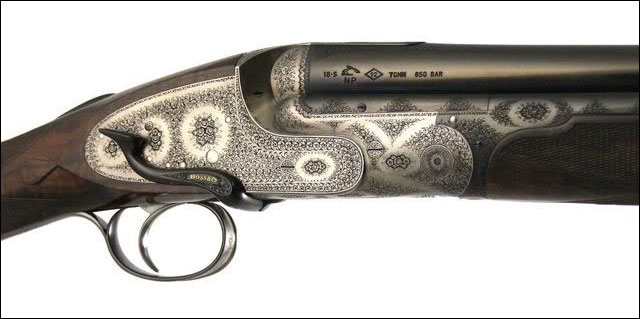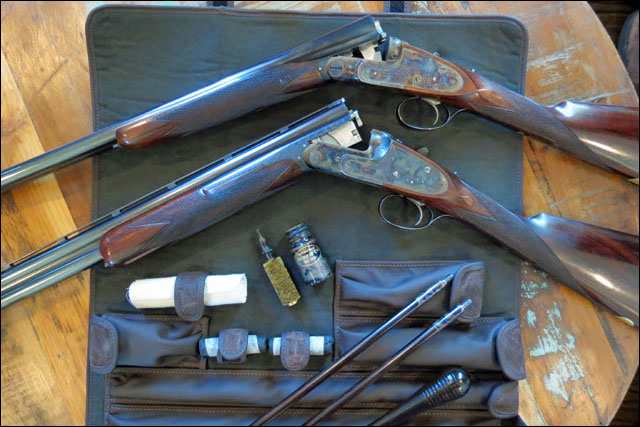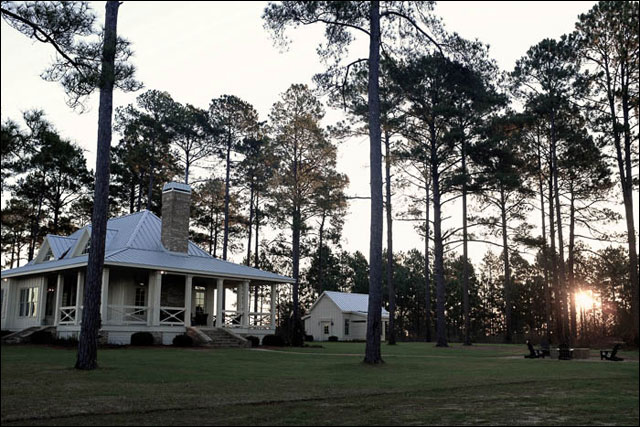Hunting Wild Quail with Arthur S. DeMoulas, the New American Owner of English Best Gun Maker Boss & Co.

The mule-drawn bird wagon trundled through Chokee Plantation in Leesburg, Georgia − a 5,800-acre homage to the vanishing wild-quail hunts that for generations put meat on the table and tendered sporting birds by the good graces of the land.
Morning temperatures were rising to the low 70s − a bit warm for the eager bird dogs confined to the kennels behind us – heating the blonde grasses and needles of the soaring pine trees to sweeten the balmy air. The southern sun soothed our bones as we ambled along to the rhythm of the wagon’s sway – a hymnal of shod hooves on soft dirt, chiming harnesses and a chorus of dogs.

Arthur S. DeMoulas with his pre-war Boss over/under at Chokee Plantation.
Reverence for our wingshooting traditions was also playing out in my conversation with Arthur S. DeMoulas, the Massachusetts business executive who purchased arguably the greatest gunmaker, Boss & Co. of London, in November 2015. He now serves as Chairman of the privately owned English company committed to making the finest shotguns and rifles in their London workshop at 110 Kew Green, Richmond, London.
During the course of a 3½-hour morning hunt, led by Chokee Manager Wendell Arrington, Mr. DeMoulas discussed his dedication to preserve the values and workmanship that have separated Boss & Co. from the other London gunmakers as the sole remaining hand-crafted London bespoke gunmaker.

Compared with the other two top London gunmakers – James Purdey and Sons and Holland & Holland – Boss & Co. is the remaining independently owned concern. As sole proprietor of Boss & Co. Mr. DeMoulas is free from the directives of quarterly reporting and the like.
“A company that’s one-hundred-percent privately owned doesn’t have to go through the same procedures and steps as one owned by a conglomerate, and that’s an advantage for us,” he explained.
That’s because he values the long view of preserving Boss & Co.’s 205-year-old approach to producing meticulous shotguns and double rifles.
“We’re not deviating from our tradition,” he noted. “We’re embracing the tradition.”

The legendary Boss Sidelever shotgun.
Case in point, Mr. DeMoulas continues to look at hiring apprentices at Boss & Co. to sustain the endangered art of making best guns by hand.
“Apprentices are the lifeblood of this business,” he told me. “We pair them up with our craftsmen” in a course of training that could take some five years for the apprentice to become proficient at the bench. “We can still do it the old fashioned way because we’re small.”
As we talked the wagon followed two guides on horseback who monitored dogs that ranged the cover for wild quail. When a dog locked on-point, the guides waved their hats and dismounted. Our conversation stopped and we immediately stepped down off the wagon, Mr. Arrington with his SKB and Mr. DeMoulas with his pre-war, 28-gauge, sidelock, Boss over/under. A guide followed the dogs’ cues and slashed at the brush with a leather whip. Suddenly 20 or 30 quail burst up in a froth of feathers scattering between trees, racing through the strobed sunlight, as Mr. DeMoulas swiveled with the covey, the Boss rising to his shoulder when shots repeated and a bird dropped.

Arthur S. DeMoulas shooting wild quail with his 28-gauge pre-war Boss over/under at Chokee Plantation.
In those moments you saw an extraordinary flashback to our Southern quail heritage. Chokee Plantation, owned by the Taylor family since 1997, has never released a penned quail on the property, with its mission of preserving wild quail habitat and hunts. And Mr. DeMoulas’ pre-war Boss, performing as its artisans intended, captured the historical exultation that the Taylors and Mr. DeMoulas are working so hard to achieve: picture-perfect wingshooting moments isolated from the perils of modernity.
For Mr. DeMoulas, the idea of a “vintage Boss” is manifested in new guns that are barely indistinguishable from the Bosses made in the 19th and 20th centuries. Under the ownership of Mr. DeMoulas “vintage” is woven into the fabric of the Boss culture rather than a serial number in the company ledgers.

Three beautiful Boss shotguns.
“Boss has a two-hundred-years-plus history of making best guns only, that allows us to go back in our archives and build any of those guns again,” he explained as we continued underway on the wagon. “We have the ability, for example, regarding a side-lever side-by-side that the company made in the late 1800s through 1941, to make them now. We can start with the 12 gauge and scale everything down proportionally to the .410. We are able to build an over/under double rifle that hasn’t been built since 1913. It’s not as though we’re coming out with a new model. Our guns are as beautiful now as they were in the 1800s and early 1900s. If you come to our company and see how our guns are made you’ll think you were back 100 years in time. The customer can specify a long bead, short bead, high bead, single or double bead, round body, whatever shape of action they like and all of that bespoke work is done by hand in our shop.”
Mr. DeMoulas believes Boss is the only gunmaker in London doing that.
He frequently travels to London as he unrelentingly embraces the ideal of the British “best gun” – a bespoke shotgun or rifle of utmost workmanship, quality and aesthetics, which stands on finish and handling over price.
Boss is thought to be the best among the best, and Mr. DeMoulas remains steadfast in safeguarding the Boss brand.

The 28-gauge, pre-war Boss side by side (top) and over/under that Arthur S. DeMoulas used for hunting wild quail at Chokee Planation, along with his custom cleaning kit.
“I bought Boss because it’s an iconic, world-known brand,” he said as the wagon slowly moved to the next covey. “You hardly ever see a Boss gun wherever you go to shoot. Boss made the fewest of the London best gunmakers. Case in point, after 205 years Boss & Co. is still in the 10,000 serial number range.”
Mr. DeMoulas also takes enormous pride in Boss’ history of innovation. The tenure of Scottish gunmaking genius John Robertson, who joined Boss in 1891 as a partner, was prophetic for the company. Mr. Robertson’s arrival was arranged by a Boss nephew, Edward Paddison, who had assumed management of the company after the death of Thomas Boss in 1857. Edward and his brother James, who died prematurely, were unable to sustain production and profitability – although gun quality remained a priority.

John Robertson (left) memorialized on the action of the Boss Bicentenary shotgun. The over/under was a 12/20 gauge combo in recognition of 2012 marking 200 years of producing best guns.
With Mr. Robertson now at the helm, Boss & Co. departed from the Paddison methodology of archaic, pragmatic designs to reach for a higher form of modern aesthetics and innovation. Mr. Robertson’s determination to combine beauty and function led to the introduction of technical breakthroughs embodied in a remarkable elegance and vision that endures today.
Driven by Mr. Robertson’s artistry and foresight, Boss & Co. introduced to the shotgun industry reliable single triggers (allowing one trigger to fire both barrels), mechanical ejectors with coil springs housed in the forend (for slimmer action profiles) and the sturdy bifurcated-lump locking system that lowered the gun’s profile for superior balance and the rounded-body action for lithe ergonomics.
But it was the Boss & Co. over/under introduced in 1909 that upended the industry. In the 2nd edition of his seminal book Boss & Co., Best Gunmakers, Donald Dallas wrote “Robertson’s over and under gun is regarded by many to be the finest of British O/Us and represented for Robertson the culmination of a career as a gunmaker.”

Arthur S. DeMoulas with one of the wild quail taken with his Boss 28-gauge over/under.
By merging his innovations, Mr. Robertson’s Boss over/under weighed a sprightly 6½ pounds with its 29-inch barrels. The new Boss stacked-barrel sidelock design shattered all preconceived biases of Gilded Age sportsmen who believed it would be ungainly and sluggish versus earlier, dominant over/unders from Germany and even the side-by-side, breech loaders of the day.
Mr. Dallas cites in his book a passage from The Country Gentleman about the new Boss over/under: “A Striking Innovation in Modern Gunnery. We have seen the same design in German weapons, but so bulky and clumsy that there was no advantage shown in them to the user. The neatness of the action and the barrels together is very marked, the workmanship being in the usual Boss superior style and finish.”
Mr. Robertson’s ingenuity made him a so-called disrupter in today’s jargon. His Boss over/under, single trigger and locking system have become the defacto configuration for nearly every target and field gun made since. The Boss shop is ground zero for the modern sporting gun.
Our Chokee guides signaled again. We hurried from the wagon, into the field – Mr. DeMoulas angling at a quick pace to the pointer. He loaded, watchful, advancing, following the guide into the grasses and shrubs. The birds were on the run and we soon lost them for good in the understory. The guides watered the dogs. Our break over, the wagon rolled again.

The lodge at Chokee Plantation.
Our discussion kept pace with the rhythm of the Chokee Plantation wild quail hunt. Mr. DeMoulas would talk passionately about his classical vision for Boss until a dog pointed. We’d rush to the spot with Mr. DeMoulas and Mr. Arrington taking the ready position. Most flushes showcased abundant coveys intermingled with singles and doubles. Clearly, the Boss shined in pursuing quick, acrobatic birds hard-wired for evasion across their native terrain.
Although our conversation largely concerned the guns and their heritage, it did turn to the reason why Mr. DeMoulas actually bought Boss & Co.
“I was over there in 1998 or 1999,” he said. “I went there to buy a pair of guns. I had some old Boss guns from the 1920s and knew how rare and beautiful they are. I went into their shop on Dover Street. It was almost like they couldn’t be bothered. And I was surprised, as a customer who flew over there, I wasn’t taken care of in the manner that I thought the customer should. It was amazing to me. I left, ended up buying two pairs of guns from one of their competitors, but I thought that company shouldn’t be run like that. That company could be so much greater if they took care of their customers. That led me to want to buy the company. That brand and that name is much greater than that and they deserve more than that. I said to my friend, I’m going to buy that company some day, and that’s how I felt every day until I bought it. I worked on that for the next several years. The passion and the brand of what Boss needs and deserves hasn’t changed for me. And that’s my whole goal and mission. Boss has a lot of potential, enormous potential, and it’s only going to realize that with a lot of hard work.”
In that vein, Guy Bignell, CEO of Griffin & Howe, said of Mr. DeMoulas “Boss & Co. now has somebody who is incredibly passionate about their brand and products, and I believe Arthur will bring a new proactive energy and life to the company.” As it turns out, Griffin & Howe, now located on Hudson Farm in Andover, New Jersey, has been representing and supporting Boss & Co. in the United States since 1927.
Lunch time was growing near. We would have soup and grilled cheese sandwiches with sweet tea on the lodge verandah. Maybe we had one or two more hunts left when Mr. DeMoulas asked if I wanted to shoot his Boss. I was hesitant. I felt reluctant to shoot one of his coveys. But he insisted and of course I accepted.
The wagon stopped. Mr. DeMoulas handed me his gun. The guide thrashed the bush when a whopping covey of wild quail erupted. I comfortably shouldered the Boss and it easily swung until I triggered the shot. Bird down. It was timeless.
Irwin Greenstein is the Publisher of Shotgun Life. You can reach him at contact@shotgunlife.com.
Helpful resources:
The web site for Chokee Planation

Irwin Greenstein is Publisher of Shotgun Life. Please send your comments to letters@shotgunlife.com.


Comments